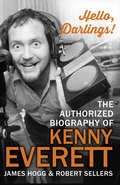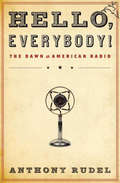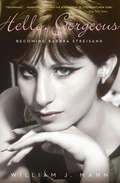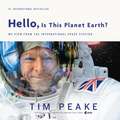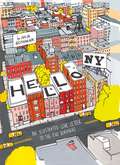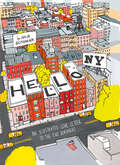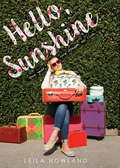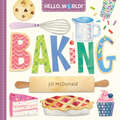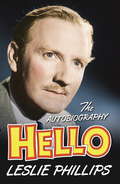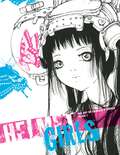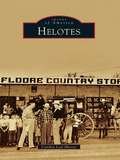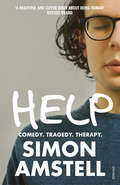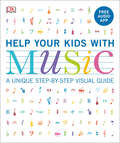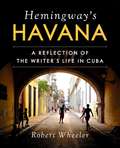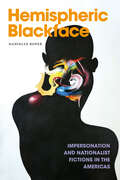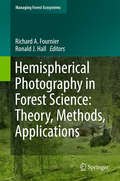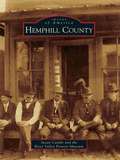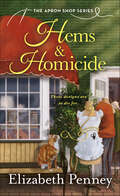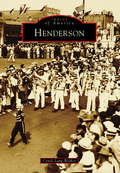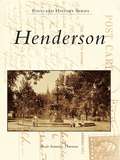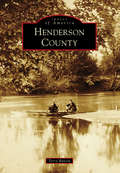- Table View
- List View
Hello, Darlings!: The Authorized Biography of Kenny Everett
by James Hogg Robert SellersSpontaneous, hilarious, irrepressible and, of course, trailblazing - Kenny Everett was revolutionary in television and radio comedy. Chris Evans, Chris Moyles, Rob Brydon and Steve Wright have all cited Kenny as a huge influence on their work - even the great Spike Milligan called him a genius. It was Kenny who developed the radio show format with which we are so familiar today: a mix of music, jingles, funny voices and sound effects. When he seamlessly made the move to television in the seventies, he created unforgettable characters such as Sid Snot, Cupid Stunt and Marcel Wave.Rarely seen without a smile on his face in public, in reality, Kenny was a deeply insecure man who suffered severe bouts of depression. He also struggled with his sexuality, only coming out to the public in 1985. Diagnosed with HIV in 1987, Kenny died in 1995.This in-depth and affectionate biography has been fully authorised by Kenny's family and contains original interviews with Kenny's sister, Kate and with his former wife, Lee, as well as entertainment figures such as Barry Cryer, Cliff Richard, Chris Tarrant and Paul Gambaccini. Packed with fabulous stories about the highs and lows of Kenny's life, his great friendships with The Beatles and Freddie Mercury, this is a book that any fan of comedy and entertainment must read.
Hello, Everybody!: The Dawn of American Radio
by Anthony Rudel&“A lively overview&” of this pre-internet mass-communication tool and &“the entrepreneurs and evangelists, hucksters and opportunists&” who flocked to it (Publishers Weekly). Long before the Internet, another young technology was transforming the way we connect with the world. At the dawn of the twentieth century, radio grew from an obscure hobby into a mass medium with the power to reach millions of people. When amateur enthusiasts began sending fuzzy signals from their garages and rooftops, radio broadcasting was born. Sensing the medium&’s potential, snake-oil salesmen and preachers took to the air, innovating styles of mass communication and entertainment while making bedlam of the airwaves. Into this wild new frontier stepped a young secretary of commerce, Herbert Hoover, whose passion for organization transformed radio into an even more powerful political, cultural and economic force. When a charismatic bandleader named Rudy Vallée created the first on-air variety show and America elected Franklin Delano Roosevelt, who communicated with the public through his famous fireside chats, radio had arrived. With extensive knowledge, humor, and an eye for outsized characters forgotten by history, Anthony Rudel tells the story of the boisterous years when radio took its place in the nation&’s living room. &“Entertaining and informative.&” —The Denver Post &“Rudel, with extensive professional radio experience, revels in the enterprising personalities who set up shop on this technological frontier. . . .[And] vividly re-creates the anything-goes atmosphere of the ether&’s early days.&” —Booklist
Hello, Gorgeous: Becoming Barbra Streisand
by William J. Mann"Barbra Streisand's story may be the most triumphant case of revenge in show business history . . . Mann vividly evokes the atmosphere of Streisand's New York."--New York Times In 1960, Barbra Streisand was just a seventeen-year-old Brooklyn kid with plenty of talent but no connections and certainly no money; her mother brought her soup to make sure she stayed fed as she took acting classes and scraped out a living. Just four years later, she was the top-selling female recording artist in America and the star of one of Broadway's biggest hits. In Hello, Gorgeous, the acclaimed Hollywood biographer William Mann chronicles that dizzying ascent, telling the riveting behind-the-scenes story of how Streisand and her team transformed her from an unknown dreamer into one of the world's most beloved superstars. "Trying to figure out the Barbra Streisand mystique is no easy task, but author William Mann expertly captures the launch of her remarkable career in the early 1960s when a unique 'star was born' . . . Mann's meticulous research and insightful analysis go deeper than any previous biography: shedding light on the formative years that shaped Streisand's persona, debunking some myths . . . and providing a cultural snapshot of the wild and free-spirited era in which Streisand blossomed."--USA Today "In his masterful book, Mann captures one of the most fully realized pictures of the multi-hyphenate superstar to date . . . Many books have been written about Streisand but few, if any, put readers as close to the subject as Mann does."--Miami Herald
Hello, Is This Planet Earth?: My View from the International Space Station
by Tim PeakeThe #1 international bestseller: An astronaut's tour of our planet from the heavens, featuring 150 mesmerizing photographs (with commentary) from the International Space Station During his six-month mission to the International Space Station, astronaut Tim Peake became the first British astronaut to complete a spacewalk--and, perhaps more astonishingly, the first to run an entire marathon in space. During his historic mission, he captured hundreds of dazzling photographs, the very best of which are collected here.Tim captures the majesty of the cosmos and of the planet we call home: breath-taking aerial photos of the world's cities illuminated at night, the natural beauty of the northern lights, and unforgettable views of oceans, mountains, and deserts.Tim's lively stories about life in space appear alongside these photographs, including the tale from which the title is taken: his famous wrong number dialed from space, when he accidentally called a stranger and asked: "Hello, is this planet Earth?" With this truly unique perspective on the incredible sights of our planet, Tim demonstrates that while in space, hundreds of miles above his friends and family, he never felt closer to home.
Hello, Neighbor!: The Kind and Caring World of Mister Rogers
by Matthew CordellKindness, caring, and reliance on our neighbors are more important now than ever before. We all need more Mister Rogers in our lives.In difficult times, Mister Rogers' Neighborhood provided a refuge for children and their families alike; a way to understand and talk about what was happening, and find hope for a brighter tomorrow. Groundbreaking in a quiet, generous way, Mister Rogers' Neighborhood introduced a generation of children to the wonders of the world in the comfort of their own living rooms. Fred Rogers took young viewers to art museums, introduced them to different professions, and talked through difficult subjects like losing a loved one, or experiencing parents' divorce, with compassion and reassurance.Share that deep respect, care, and quiet joy in the day-to-day with the only authorized picture book biography of Fred Rogers--lovingly created by Caldecott Medalist Matt Cordell.Lively, colorful illustrations explore Fred Rogers' early life and the events that led him to create his enduring show. Exclusively published archival photographs, provided by Fred Rogers Productions, offer a behind-the-scenes look at this historic show and the people whose hard work made it possible. A brief biography of Mister Rogers and a history of the show is included, as well as a note from author-illustrator Matt Cordell about his inspiration and longtime admiration for Fred Rogers and Mister Rogers' Neighborhood.Perfect for fans of the film A Beautiful Day in the Neighborhood, starring Tom Hanks, or anyone who wants to bring home the ideals of compassion, kindness, and patience that make us all good neighbors, this captivating picture book should not be missed.A Junior Library Guild SelectionA Bank Street Best Children's Book of the Year!
Hello, New York: An Illustrated Love Letter to the Five Boroughs
by Julia RothmanAnyone who hearts New York will love this illustrated homage to the city. Artist, author, and New Yorker Julia Rothman brings humor and tenderness to an eclectic assortment of historical tidbits (how the New York Public Library lion sculptures got their names), idiosyncratic places to visit (where to find the tennis courts at Grand Central Station), interviews with locals (thoughts on love from a Hasidic Jewish landlord), and personal recollections from growing up in the Bronx (fried fish at Johnny's Reef)—all illuminated in her beloved signature style. A uniquely entertaining and informative city guide, this slice of the Big Apple will delight New York locals and visitors alike.
Hello, New York: An Illustrated Love Letter to the Five Boroughs
by Julia Rothman&“An endearing combination [of] memoir and Baedeker . . . serves up factoids and ruminations&” along with illustrations of NYC sights from a native artist (The New York Times). Anyone who hearts New York will love this illustrated homage to the city. Artist, author, and New Yorker Julia Rothman brings humor and tenderness to an eclectic assortment of historical tidbits (how the New York Public Library lion sculptures got their names), idiosyncratic places to visit (where to find the tennis courts at Grand Central Station), interviews with locals (thoughts on love from a Hasidic Jewish landlord), and personal recollections from growing up in the Bronx (fried fish at Johnny&’s Reef)—all illuminated in her beloved signature style. A uniquely entertaining and informative city guide, this slice of the Big Apple will delight New York locals and visitors alike. &“The perfect book if you&’ve been to the city a million times, live here or have it on your bucket list.&” —Design Sponge &“From bodegas to bras, a visual serenade to Gotham's emblems and eccentricities.&” —Maria Popova, Brain Pickings &“This &‘illustrated love letter to the five boroughs&’ is also a guidebook full of details, including where the original Original Ray&’s was, and a journal about oddly memorable New York moments.&” —Time Out NY &“ . . . A whimsical, kaleidoscopic perspective on a city that's changing by the second.&” —Fast Company
Hello, Sunshine
by Leila HowlandA Prep School Girl with a Hollywood DreamBecca Harrington is a reject. After being rebuffed by every college on her list, she needs a fresh start, so she packs up everything and moves to LA, giving herself one year to land an acting gig or kill herself trying. Unfortunately, not everything turns out as planned, and after a few grueling months, LA is looking like the worst idea ever. As hard as she tries, Becca can't land an agent, she's running out of cash, and her mom is hounding her to apply to more schools. In an act of desperation, Becca and her friend Marisol start posting short videos online-with the help of their adorable filmmaker neighbor, Raj-and the videos catch the attention of a TV producer. Could this be it? Her big break? Or will she have to move back home with nothing but some bad head shots and a monstrous credit-card bill? Becca may not get the Hollywood ending she was hoping for, but perhaps she'll learn there's more than one way to achieve her dream.Readers will love every page of this funny, romantic, aspirational, and ultimately triumphant novel about a girl who just wants to make it on her own. Praise for Nantucket Blue"[Howland] evokes the Nantucket setting vividly . . . when it comes to indulgent beach reading, sometimes it's more fun to get pushed over by a wave than to stay safely on your towel." -The New York Times "Sand, secrets, Nantucket Reds, and romance. A fresh, feel-good debut." -The Boston Globe Praise for Nantucket RedEnjoyable and introspective, this is more than just a summer beach read." -Kirkus Reviews
Hello, World! Baking (Hello, World!)
by Jill McDonaldFamilies who bake together will love this super-sweet nonfiction book from the bestselling series Hello, World! A great gift for the holiday baking season!Kids can learn all about the joys of baking in this cheerful and informative book—with colors, shapes, sizes, and super-simple facts. ("The yellow circle in the middle of an egg is called a yolk.")Told in easy-to-understand terms alongside bright illustrations of baking utensils, ingredients, and treats such as pies, cupcakes, bread, and cookies, this book makes learning easy for little ones and offers useful prompts to help adults engage with the reader on each page.It's a perfect way to bring the love of baking into the busy world of babies, toddlers, and preschoolers, where learning never stops.Look for all the books in the Hello, World! series:Solar System • Weather • Backyard Bugs • Birds • Dinosaurs • My Body • How Do Apples Grow? • Ocean Life • Moon Landing • Pets • Arctic Animals • Construction Site • Rainforest Animals • Planet Earth • Reptiles • Cars and Trucks • Music • Baby Animals • On the Farm • Garden Time • Planes and Other Flying Machines • Rocks and Minerals • Snow • Let's Go Camping • School Day • Bedtime • From Seed to Pumpkin • Rockets and Other Space Machines • Baking
Hello: The Autobiography
by Leslie PhillipsThe autobiography of a true national treasure, an actor who has featured in more British Number One box office smashes than anyone else.Leslie Phillips's story begins with a poverty-stricken childhood in north London, made all the worse when his father died when Leslie was just ten years old. Soon after, he began his acting career, and since then he has worked with all the greats, from Laurence Olivier to Steven Spielberg.Best known for his comic roles in the Carry On and Doctor series, he took the decision in later life to take on more serious roles in films such as Empire of the Sun, Out of Africa and Scandal, as well as performing in plays such as The Cherry Orchard.Packed with hilarious anecdotes, in this long-awaited autobiography he recalls some of the great characters he has worked with, and also highlights how different he is in real life from his onscreen persona as a bounder. It is a fascinating story, brilliantly told.
Hello: The Autobiography
by Leslie PhillipsThe autobiography of a true national treasure, an actor who has featured in more British Number One box office smashes than anyone else.Leslie Phillips's story begins with a poverty-stricken childhood in north London, made all the worse when his father died when Leslie was just ten years old. Soon after, he began his acting career, and since then he has worked with all the greats, from Laurence Olivier to Steven Spielberg.Best known for his comic roles in the Carry On and Doctor series, he took the decision in later life to take on more serious roles in films such as Empire of the Sun, Out of Africa and Scandal, as well as performing in plays such as The Cherry Orchard.Packed with hilarious anecdotes, in this long-awaited autobiography he recalls some of the great characters he has worked with, and also highlights how different he is in real life from his onscreen persona as a bounder. It is a fascinating story, brilliantly told.
Helmetgirls: The Art of Camilla d'Errico Volume 2
by Camilla d'ErricoCamilla d&’Errico is a powerful voice in pop surrealism, her work combining diverse influences in imagery is both singular and hauntingly familiar. Compelling and deeply personal, Helmetgirlsdocuments Camilla&’s art and lifestyle brand that fuses manga, steampunk, and fine art into an original and meaningful aggregate. Gargantuan biomechanical headgear adorns beautiful, wide-eyed, and seemingly fragile girls. More than just decoration, the helmets express each girl&’s character, needs, and desires. Look deeply into the Helmetgirls&’ eyes—they have a story to tell.* Camilla&’s art has appeared in major pop-culture magazines and in galleries around the world.
Helotes
by Cynthia Leal MasseyA small town with a big history, Helotes--20 miles northwest of downtown San Antonio--was named for the Spanish word elotes, or corn on the cob. So extensive were the fields of corn along its namesake creek, a Spanish official in 1723 called the area el Puerto de los Olotes, or Corncob Pass. When settlers later arrived, few ancient cornfields remained. Situated along Bandera Road, the town became a stagecoach stop, and a post office was established in 1873. Nevertheless, the settlement remained rural for the next 100 years. Helotes, known as a place to "let down yer hair and kick up yer heels," solidified its reputation in 1946, when John T. Floore Country Store, a dance hall and concert venue for top-rated country musicians, opened for business in downtown Helotes. The annual Cornyval Festival, inaugurated in 1966, continues this tradition. Incorporated in 1981, the town provides a verdant and hilly escape from the city.
Help
by Simon Amstell'A beautiful and clever book about being human' Russell BrandCOMEDY. TRAGEDY. THERAPY. Simon Amstell did his first stand-up gig at the age of thirteen. His parents had just divorced and puberty was confusing. Trying to be funny solved everything. HELP is the hilarious and heartbreaking account of Simon’s ongoing compulsion to reveal his entire self on stage. To tell the truth so it can’t hurt him any more. Loneliness, anxiety, depression – this book has it all. And more. From a complicated childhood in Essex to an Ayahuasca-led epiphany in the Amazon rainforest, this story will make you laugh, cry and then feel happier than you’ve ever been.
Help Your Kids with Music, Ages 10-16: A Unique Step-by-Step Visual Guide & Free Audio App (DK Help Your Kids)
by Carol VordermanDemystify the subject of music theory with this visual guide, reducing the stress of studying music and helping your child with their music homework. With free online audio.Covering everything from semitones and note values to harmony and music appreciation, Help Your Kids with Music takes you on a clear and easy step-by-step path through all things music. With free supporting audio available. This straightforward guide uses clear, accessible pictures and diagrams to approach even the most complex musical theory with confidence. The use of bright colors breaks up the black and white confusion of musical notes and helps you to easily understand key topics. You&’ll also find a glossary of key musical terms and symbols for quick reference, and a supporting audio to help you understand the music you are seeing. This visual guide clearly explains key concepts in five step-by-step chapters:- The Basics explains the types of instruments, notation for keyboard and stringed instruments, the "musical alphabet," and counting a beat.- Rhythm covers the length of notes and rests, as well as basic rhythms and meters, phrasing, syncopation, tempo, and using a metronome- Tone and Melody includes everything a student needs to know about tones and how they work together to build a melody- Chords and Harmony shows how intervals work together and includes examples for horn and woodwind instruments- Form and Interpretation helps students understand how musical form can aid appreciation and interpretation for classical, jazz, blues, and other musical styles.Suitable for those working on music at school or as an extra subject, this valuable guide covers music theory from Grades 1-5. Whether you're approaching the subject yourself or simply supporting someone else through their studies, Help Your Kids with Music simplifies the world of musical notation and study for everyone.Series OverviewDK's bestselling Help Your Kids With series contains crystal-clear visual breakdowns of important subjects. Simple illustrations and clear text are key to making this series a user-friendly resource for frustrated parents who want to help their children get the most out of school.
Helping Out
by George AnconaIt's fun to work beside a group of grown-ups. You can learn new skills this way. But, even better, you can have a great time just being in the adult world. Helping Out shows young people lending a hand with many different grown-up jobs. You'll see them at work inside and out, at home or at school, in the city or on a farm. And you're sure to start thinking of jobs you might do to share the special rewards that come with helping.
Hemingway's Havana: A Reflection of the Writer's Life in Cuba
by Robert Wheeler América FuentesErnest Hemingway lived in Cuba for more than two decades, longer than anywhere else. He bought a home—naming it the Finca Vigia—with his third wife, Martha Gellhorn and wrote his masterpiece The Old Man and the Sea there. In Cuba, Papa Hemingway found a sense of serenity and enrichment that he couldn’t find anywhere else. Now, through more than a hundred color photographs and accompanying text, Robert Wheeler takes us through the streets and near the water’s edge of Havana, and closer to the relationship Hemingway shared with the Cuban people, their landscape, their politics, and their culture. Wheeler has followed Hemingway’s path across continents—from La Closerie des Lilas Café in Paris to Sloppy Joe’s Bar in Key West to El Floridita in Havana—seeking to capture through photography and the written word the essence of one of the greatest writers in the English language. In Hemingway’s Havana, he reveals the beauty and the allure of Cuba, an island nation whose deep connection with the sea came to fascinate and inspire the writer. The book includes a foreword by América Fuentes who is the granddaughter of the late Gregorio Fuentes, the captain of Hemingway’s boat Pilar and his loyal and close friend.
Hemispheric Blackface: Impersonation and Nationalist Fictions in the Americas (Dissident Acts)
by Danielle RoperIn Hemispheric Blackface, Danielle Roper examines blackface performance and its relationship to twentieth- and twenty-first-century nationalist fictions of mestizaje, creole nationalism, and other versions of postracialism in the Americas. Challenging both the dominance of the US minstrel tradition and the focus on the nation in blackface studies, Roper maps a hemispheric network of racial impersonation in Peru, Bolivia, Colombia, Jamaica, Cuba, and Miami. She analyzes blackface performance in the aftermath of the turn to multiculturalism in Latin America, the emergence of modern blackness in Jamaica, and the rise of Barack Obama in the United States, showing how blackface remains embedded in cultural entertainment. Contending that the Americas are linked by repeating nationalist fictions of postracialism, colorblindness, and myths of racial democracy, Roper assesses how acts of impersonation mediate the ongoing power of these narratives and enable people to comprehend advancements and reversals in racial equality. Rather than simply framing blackface as liberatory or oppressive, Roper traces its emergence from a shared history of slavery and the varied politics of racial enjoyment throughout the hemisphere.
Hemispherical Photography in Forest Science: Theory, Methods, Applications
by Richard A. Fournier Ronald J. HallThis book presents practical information about hemispherical photography from the perspectives of field data acquisition, image processing and information retrieval methods. This book is organized into three sections. The first section describes what is hemispherical photography and what are the fundamental elements of forest structure and light interactions within the forest canopy. The second section provides practical information about the equipment, procedures and tools for procuring, processing and analyzing hemispherical photographs. Armed with this information, the third section describes several applications of hemispherical photographs to forestry and natural resource assessment. The book concludes with a discussion about modelling tools and future directions of this rapidly growing field. There is currently no information source on the market that has this comprehensive range of topics combined in a single book. The book will appeal to academics, graduate students, natural resource professionals and researchers alike.
Hemphill County (Images of America)
by River Valley Pioneer Museum Susan CaudleFrom Spanish conquistadores and American Indian battles to railroads and oil booms, Hemphill County has seen it all. Located in the northeast Panhandle, Hemphill County is a land of sage-covered sand hills and rolling breaks, with towering buttes and deep canyons cut by the Canadian River. Once inhabited by the ancient mammoth and mastodon and, more recently, thundering herds of bison, Hemphill County has a rich human history too. It was home to the Kiowa, Comanche, and Cheyenne Indians and was crossed by Coronado's famous expedition in 1540. American Indian fights, such as the Battle of Buffalo Wallow, also occurred here. Canadian, the county seat, has a unique history of its own. This oasis located on the banks of the Canadian River was the site of the first rodeo in Texas and a stop on the Santa Fe Railway. Other commerce soon followed, including a successful ranching and farming culture, as well as many thriving oil and natural gas industries.
Hems & Homicide: The Apron Shop Series (The Apron Shop Series #1)
by Elizabeth PenneyWelcome to the first in the Apron Shop mystery series by Elizabeth Penney, set in the quaint village of Blueberry Cove, Maine where an expert seamstress turned amateur sleuth is getting measured for murder. . .Iris Buckley is sew ready for a change. After the death of her beloved grandfather, Iris decides to stay in her Maine hometown to help out her widowed grandmother, Anne—and bring her online hand-made apron designs to real-time retail life. Her and Anne’s shop, Ruffles & Bows, is set to include all the latest and vintage linen fashions, a studio for sewing groups and classes, and a friendly orange cat. The only thing that they were not planning to have on the property? A skeleton in the basementAnne recognizes the remains of an old friend, and when a second body shows up in the apron shop—this time their corrupt landlord, whom Anne had been feuding with for decades—she becomes a prime suspect. Now, it’s up to Iris to help clear her name. Enlisting the help of her old high-school crush Ian Stewart who, like certain fabrics, has only gotten better-looking with age and her plucky BFF Madison Morris, Iris must piece together an investigation to find out who the real killer is. . .and find a way to keep her brand-new business from being scrapped in the process.
Henderson
by Cyndi Long WalkerOne of the oldest towns in Texas, Henderson--founded in 1843--is situated in the rolling green hills and pine forests of East Texas. Named for the state's first governor, James P. Henderson, the town is the seat of Rusk County. Henderson's fertile land and abundant stores of clay were enjoyed for centuries by Caddo Indians and other indigenous people; after settlement by Anglos, beginning in the 1830s, the area became known for cotton plantations. More Old South than Old West, Henderson might have had spectacular growth if the planned Galveston, Houston & Henderson Railroad had come to fruition. When that did not happen, Henderson relied on an economy based on cotton, farming, and logging until the Great East Texas Oilfield was discovered in 1930 just a few miles west. Oil, and later the commercial production of bricks, paved the way for a brighter future for the town, which today is still partially sustained by the riches of the earth through lignite production. Generations of hardworking men and women have called Henderson home, and the town today enjoys a revitalized town square filled with shops and restaurants.
Henderson (Postcard History)
by Susan Sommers ThurmanThese vintage picture postcards take readers on a trip through the history of Henderson. Featured are the city's many remarkable parks, businesses, hotels, schools, and homes--some lost to time and some transported into the 21st century. The images and stories in this book will entertain and educate architecture buffs, rail fans, river enthusiasts, historians, and visitors and residents, past and present.
Henna Is . . .
by Marzieh AbbasA picture book that serves young readers as a lyrical love letter to henna, written by Muslim Book Reviewer Award winner Marzieh Abbas and brilliantly illustrated by Anu Chouhan. Henna is so much more than a form of temporary body art.Henna is nature—seeds sprouted into shrubs, leaves kissed by tropical rain.Henna is color—the orange of juicy mangoes, sun-kissed brown, or black as the feathers of crows.Henna is fragrance—earthy and nutty, lemony and clove-y.The intricate patterns of flowers, feathers, vines, and other symbols painted and stained onto skin has been a tradition in cultures all around the world for thousands of years. Beautiful and eye-catching, henna also carries the scents, textures, and colors of family and identity.
